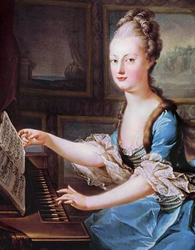The most beautiful daughter of the Austrian emperor, Marie Antoinette was guaranteed a life of privilege. But as the teen bride of French King Louis XVI, her free spending, decadent lifestyle angered the working class, who saw her as the embodiment of all that was wrong with the monarchy.
Marie Antoinette’s Early Days
Born on November 2, 1755, the day of a great earthquake in Lisbon, Marie Antoinette seemed destined for dramatic upheaval. The 15th child born to Holy Roman Emperor Francis I and Archduchess Maria Theresa of Austria, she spent her first years known as Maria Antonia.
During her childhood, Marie Antoinette did not receive much attention from her parents and according to some accounts, her mother sought fear and respect rather than love from her children. Constantly surrounded by tutors and governesses, Marie Antoinette was trained in some subjects, but did not receive formal schooling. According to Madame Campan, who would later serve as her lady-in-waiting, Marie Antoinette’s tutors completed much of her work for her, leaving her with only the most basic knowledge of languages and history.
At the end of the Seven Years’ War, during which Austria and France were allies, eight-year-old Marie Antoinette was promised in marriage to the grandson of the French king. When she was 14, she was sent to marry Louis-Auguste and made to leave all of her Austrian clothing and belongings behind in honor of her new French citizenship.
Sources in this Story
- Authorama: Memoirs of Marie Antoinette by Campan: Chapter II
- The World of Royalty: Marie Antoinette, Louis XVI and the French Revolution
- The Straight Dope: Did Marie Antoinette really say “Let them eat cake”?
- Tea at Trianon: Madame Déficit
- PBS: Marie Antoinette and the French Revolution: Timeline
- Rotten Tomatoes: Marie Antoinette (2006)
Marie Antoinette’s Notable Accomplishments
Marie Antoinette did not bear her husband any children for quite some time, a fact which frustrated the royal family and sparked much gossip and speculation among the general public, many of whom called for the annulment of the marriage. Marie Antoinette indicated to her mother that she did not consummate the marriage for seven years, and it is possible that surgery was required before the dauphin could father children.
Marie Antoinette reportedly did not take well to life at court. Having been shielded from courtly rituals at home, the French custom of formality for nearly every event irritated the young dauphine, who rebelled by choosing her own fashions and friends, and misbehaved during royal events.
Louis-Auguste and Marie assumed the French throne in 1774 after Louis XV died from smallpox. The couple did not see each other often; Marie Antoinette busied herself with gambling, outings to operas, and current fashion. Pervasive rumors of her frivolity persisted among the public, while they themselves faced lean times after a poor harvest. It was during this time that the popular quote “Let them eat cake,” was attributed to Marie Antoinette, as her solution to the farmers’ request for subsidized bread.
But as time passed, Marie Antoinette matured and attempted to cut household expenses and bore the King a child in 1778. Three years later she produced a male heir, a feat that cemented her influence in the palace and in the King’s life. She increasingly spent time at a country retreat, which inflamed her detractors, who circulated hateful pamphlets, portraying her as an adulterous, self-centered woman who was neglecting the French people.
The Woman and her Work
- “Marie Antoinette: The Journey” by Antonia Fraser
- “Queen of Fashion: What Marie Antoinette Wore to the Revolution” by Caroline Weber
- “The Private Realm of Marie Antoinette” by Marie-France Boyer
- “The Private Life of Marie Antoinette” by Madame Campan
- “Marie Antoinette and the Last Garden at Versailles” by Christian Duvernois
The Rest of the Story
When France fell into financial ruin in late 1787, many people held Marie Antoinette responsible for the troubles, blaming her excesses and her influence on the King as the cause of his poor decisions. The French common people, known as the Third Estate, were increasingly unhappy with their representation in government and in 1789, they formed their own ruling group, the National Assembly.
Although her husband supported them, Marie Antoinette opposed any rule other than an absolute monarchy. French citizens forced the royal family out of their palace at Versailles in October 1789. They moved to the Palace of the Tuileries, where they lived a more modest existence, during which time both Louis XVI and Antoinette wrote abroad for help. The family attempted escape, but were captured and eventually formally imprisoned and in August of 1792, the monarchy was officially abolished.
Louis XVI was executed for treason in January 1793. After 10 months of being jailed and separated from her children, Marie Antoinette was put on trial in October 1794. She was charged with treason, sexually abusing her son and other offenses and found guilty. On October 16, 1794, Marie Antoinette was executed by guillotine.
Much has been written about the queen who lost her head; in 2006, she got the lavish Hollywood treatment by acclaimed director Sofia Coppola, although the film was not terribly well received.
This article was originally written by Jennifer Ferris; it was updated October 29, 2017.











